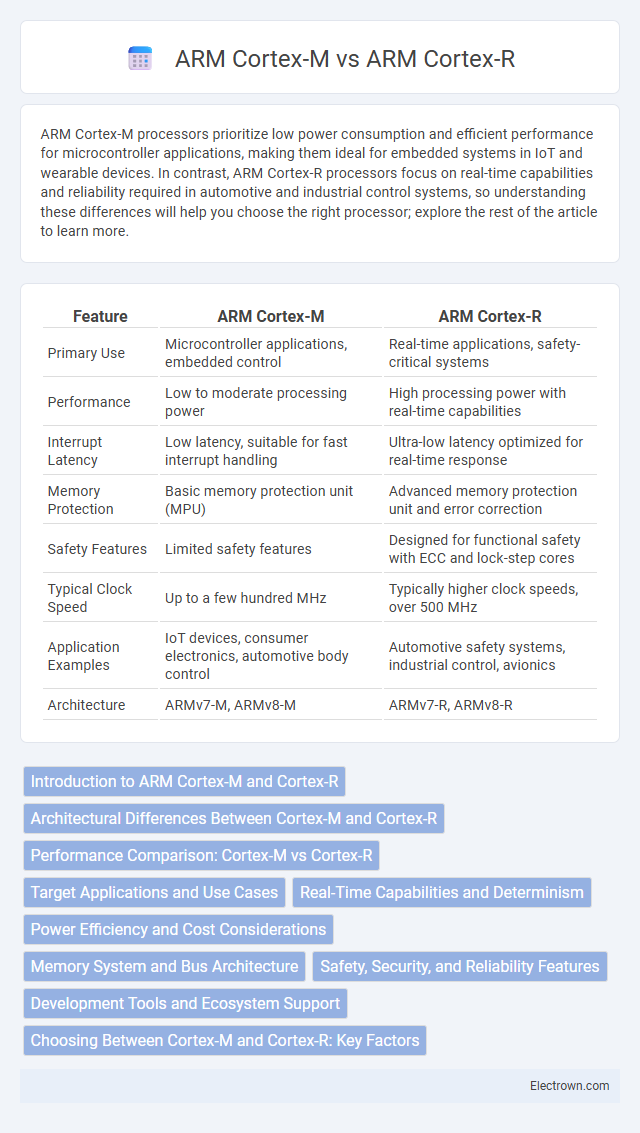ARM Cortex-M processors prioritize low power consumption and efficient performance for microcontroller applications, making them ideal for embedded systems in IoT and wearable devices. In contrast, ARM Cortex-R processors focus on real-time capabilities and reliability required in automotive and industrial control systems, so understanding these differences will help you choose the right processor; explore the rest of the article to learn more.
Table of Comparison
| Feature | ARM Cortex-M | ARM Cortex-R |
|---|---|---|
| Primary Use | Microcontroller applications, embedded control | Real-time applications, safety-critical systems |
| Performance | Low to moderate processing power | High processing power with real-time capabilities |
| Interrupt Latency | Low latency, suitable for fast interrupt handling | Ultra-low latency optimized for real-time response |
| Memory Protection | Basic memory protection unit (MPU) | Advanced memory protection unit and error correction |
| Safety Features | Limited safety features | Designed for functional safety with ECC and lock-step cores |
| Typical Clock Speed | Up to a few hundred MHz | Typically higher clock speeds, over 500 MHz |
| Application Examples | IoT devices, consumer electronics, automotive body control | Automotive safety systems, industrial control, avionics |
| Architecture | ARMv7-M, ARMv8-M | ARMv7-R, ARMv8-R |
Introduction to ARM Cortex-M and Cortex-R
ARM Cortex-M processors are engineered for low-power microcontroller applications, offering efficient real-time performance in embedded systems like IoT devices and automotive controls. ARM Cortex-R processors provide high reliability and deterministic response times, optimized for safety-critical and hard real-time applications such as automotive braking systems and industrial robotics. Both families utilize ARM architecture but target distinct markets with Cortex-M emphasizing energy efficiency and Cortex-R focusing on robust fault tolerance and fast interrupt handling.
Architectural Differences Between Cortex-M and Cortex-R
ARM Cortex-M processors feature a simpler, deterministic pipeline optimized for low-latency interrupt handling and real-time control in microcontrollers. Cortex-R cores incorporate error-correcting code (ECC) memory protection, dual-issue pipelines, and lock-step redundancy for high reliability and fault tolerance in safety-critical applications. Your choice between Cortex-M and Cortex-R depends on prioritizing either efficient microcontroller performance or robust real-time processing with stringent safety requirements.
Performance Comparison: Cortex-M vs Cortex-R
ARM Cortex-R processors offer higher performance and real-time responsiveness compared to Cortex-M, featuring faster clock speeds and more advanced pipeline architectures designed for deterministic execution. Cortex-M cores prioritize energy efficiency and are optimized for low-power applications, making them suitable for embedded systems with moderate processing needs. Your choice depends on whether real-time performance and fault tolerance in safety-critical environments outweigh the power-saving benefits of Cortex-M cores.
Target Applications and Use Cases
ARM Cortex-M processors are optimized for low-power, cost-sensitive embedded applications such as microcontrollers in IoT devices, wearable technology, and automotive body control systems. ARM Cortex-R processors are designed for real-time, high-reliability applications including automotive safety systems, hard disk drives, and industrial robotics where deterministic performance and fault tolerance are critical. Cortex-M emphasizes energy efficiency and ease of use in mass-market products, while Cortex-R prioritizes robust error correction and fast interrupt handling for mission-critical environments.
Real-Time Capabilities and Determinism
ARM Cortex-R processors deliver superior real-time capabilities and deterministic performance designed for safety-critical applications such as automotive and industrial control systems. Their architecture includes features like tightly coupled memory, interrupt latency optimization, and error-correcting code (ECC) support, ensuring consistent and predictable response times. In contrast, ARM Cortex-M processors target lower-power embedded systems with reasonable real-time capabilities but less stringent determinism guarantees.
Power Efficiency and Cost Considerations
ARM Cortex-M processors deliver high power efficiency with low active and standby power consumption, making them ideal for cost-sensitive, battery-powered applications such as IoT devices and wearables. ARM Cortex-R cores, designed for real-time performance and reliability, typically consume more power and are positioned at a higher cost point due to advanced features like error correction and lock-step operation. Cost considerations favor Cortex-M for mass-market, energy-constrained products, while Cortex-R targets automotive and industrial systems requiring deterministic behavior and robustness.
Memory System and Bus Architecture
ARM Cortex-M processors utilize a Harvard architecture with separate instruction and data buses, optimizing throughput and low-latency access for embedded applications. Their memory system supports tightly coupled memory (TCM) and single-cycle access to SRAM, enhancing deterministic real-time performance. In contrast, ARM Cortex-R processors feature a Harvard architecture combined with coherent multi-port memory and error correction code (ECC) capabilities, designed for high-reliability systems requiring fault tolerance and robust bus interfaces such as AMBA 3 AXI for low-latency, high-throughput memory access.
Safety, Security, and Reliability Features
ARM Cortex-M processors prioritize safety and security with built-in fault detection mechanisms and TrustZone technology to isolate sensitive code, making them ideal for embedded applications requiring robust reliability. ARM Cortex-R processors, designed for real-time systems, emphasize reliability with hardware error correction codes (ECC), dual-core lock-step operation, and advanced memory protection, ensuring high safety in critical environments like automotive and industrial control. When selecting a processor for Your application, consider Cortex-M for general embedded safety and Cortex-R for stringent real-time safety and fault tolerance needs.
Development Tools and Ecosystem Support
ARM Cortex-M processors benefit from extensive development tools and ecosystem support, including CMSIS (Cortex Microcontroller Software Interface Standard), numerous IDE options like Keil MDK and IAR Embedded Workbench, and broad middleware compatibility tailored for real-time applications in microcontrollers. Cortex-R processors feature specialized tools optimized for high-reliability, safety-critical systems, with support for development environments such as ARM DS-5 and Lauterbach TRACE32, alongside robust debugging and trace capabilities essential for automotive and industrial use. Both families leverage ARM's extensive ecosystem, but Cortex-M targets low-power, cost-sensitive designs while Cortex-R emphasizes fault tolerance and deterministic performance in safety-critical environments.
Choosing Between Cortex-M and Cortex-R: Key Factors
Choosing between ARM Cortex-M and ARM Cortex-R hinges on your application's real-time performance and reliability requirements. Cortex-M cores prioritize low power consumption and efficient processing for deeply embedded systems, making them ideal for cost-sensitive, low-latency tasks. Cortex-R cores deliver higher fault tolerance and deterministic response times, crucial for safety-critical systems such as automotive control and industrial automation.
ARM Cortex-M vs ARM Cortex-R Infographic

 electrown.com
electrown.com